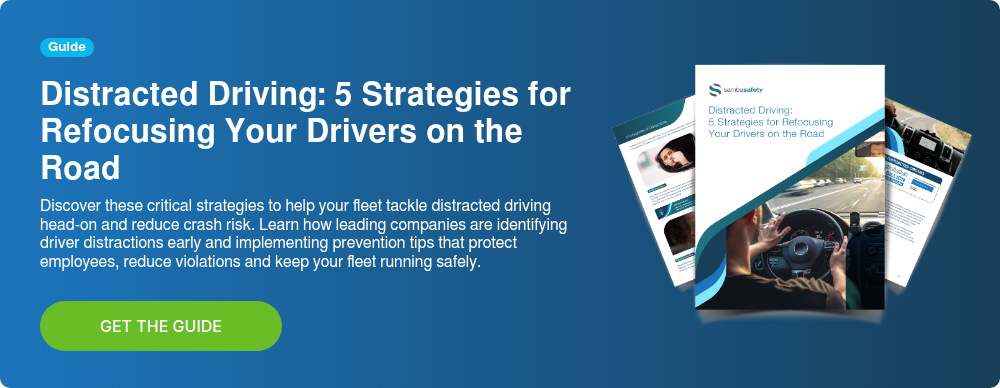
When your employees drive for work, whether in a fleet vehicle or their personal car, they take on risk. That risk has real consequences for your business. A single moment of distraction behind the wheel can lead to a violation, a crash, a lawsuit or worse. And while distracted driving is often associated with texting, the reality is far more complex. It comes in many forms: some you can see and others you can’t. Knowing the different types of distracted driving and how they show up on the road is essential for employers looking to reduce risk and protect their workforce. We break down all four types of distracted driving below.
Looking to Combat Fleet Distracted Driving?
Check Out These 5 Proven Strategies
What Are the Four Types of Distracted Driving?
Distraction shows up in multiple ways, and not all of them are easy to spot. There are four main types of distracted driving:
- Visual distractions
- Manual distractions
- Auditory distractions
- Cognitive distractions
Each type interferes with safe driving in a different way, and each one can turn an everyday task, like checking directions or answering a call, into a serious safety risk. The better your team understands these categories, the more equipped you’ll be to prevent distracted driving before it leads to violations, crashes and claims.
Visual Distractions
Visual distractions happen when drivers take their eyes off the road, even briefly. In personal driving, that might mean glancing at a phone. But in fleet driving, the risks multiply. Employees may be checking a dispatch message, reading a customer address on a delivery slip or looking down to adjust a route on a GPS. Some of these tasks may seem harmless, until something unexpected happens on the road and the driver isn’t looking.
For employers, the danger lies in the seconds lost. It takes approximately 4.6 seconds to read an incoming text message, the equivalent (at 55 MPH) of traveling the length of an entire football field, blind. If that leads to a rear-end crash, an injury or worse, your company could face claims, lawsuits and reputational damage.
Manual Distractions
Manual distraction occurs when a driver takes one or both hands off the wheel to do something else. Eating, reaching for a drink, texting, entering an address into a navigation system or even flipping through paperwork between job sites are all common scenarios among work drivers.
In fleet operations, these behaviors often stem from pressure to multitask. A driver might feel rushed to keep to a tight schedule or manage multiple tasks without stopping. But any time their hands are off the wheel, they’re not in full control of the vehicle. That means longer reaction times and a higher likelihood of losing control in an emergency situation.
Auditory Distractions
Auditory distraction happens when a driver’s attention is pulled away by sound. That might include a hands-free phone call, loud music playing to stay alert during long drives or a constant stream of notifications from work apps. Even though the driver’s eyes may still be on the road, their brain is processing those sounds, diverting cognitive bandwidth away from driving.
This type of distraction is especially critical for work-related drivers, who often operate in dynamic, unpredictable environments. Construction zones, pedestrians, emergency vehicles and sudden changes in traffic all require constant vigilance. If a driver is on a call, especially one that’s emotionally charged or decision-heavy, they’re far less equipped to respond quickly to danger.
From a business perspective, this matters. Your drivers might be complying with hands-free laws and still be dangerously distracted. And if a crash occurs, legal teams will scrutinize not just what your drivers were doing, but what your company allows, tolerates or encourages behind the wheel. That includes work-related calls and communications.
Cognitive Distractions
Cognitive distraction is the silent risk. The driver appears to be doing everything right—eyes on the road, hands on the wheel and no phone in sight—but their mind is elsewhere. They’re replaying a stressful conversation, worrying about deadlines, thinking about the next stop or simply zoning out during a long, monotonous stretch of highway.
Fleet drivers are especially vulnerable to this kind of distraction. They may drive for hours at a time, often alone, navigating high-pressure schedules or shifting priorities. Cognitive fatigue can sneak up on them, and the result is a driver who misses traffic signals, reacts slowly or completely fails to register hazards in their path.
For employers, this is one of the hardest risks to detect but one of the most important to address. It’s not enough to discourage phone use. You have to create a culture that values mental readiness and proactive driving. That includes not overloading drivers, providing adequate breaks and using monitored driving activity to identify signs of driver fatigue or stress that could lead to cognitive lapses behind the wheel.
Why This Matters for Employers
Each type of distraction brings unique dangers. And when your drivers are representing your company out on the road, the stakes go well beyond traffic citations. Every distracted driving incident carries the potential for financial loss, legal exposure and brand damage. More than that, it puts lives at risk.
Distracted driving behaviors, whether recorded through telematics or violations observed by law enforcement, are red flags. They indicate where your fleet may be vulnerable. They show where your driver safety policies or training could be falling short. And in today’s litigious climate, they can quickly become evidence of negligence if not addressed.
For companies operating in regulated industries, there may be additional compliance concerns around hours of service (HOS), mobile device use and post-incident procedures. But even in non-regulated environments, the liability remains. Courts don’t differentiate between DOT-regulated and non-regulated drivers when determining whether a company took reasonable steps to prevent harm.
Combat All Four Types of Distracted Driving
Our distracted driving guide breaks down five actionable strategies your fleet can implement to combat all four types of distracted driving, reduce violations and create a stronger safety culture across your workforce. Visit the link below to grab your free copy!




